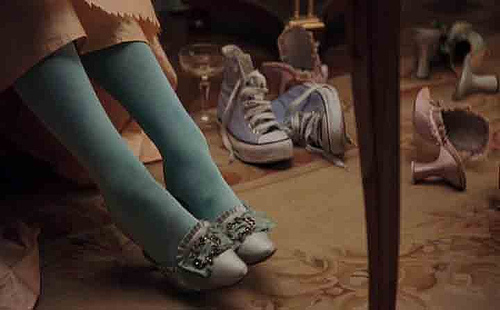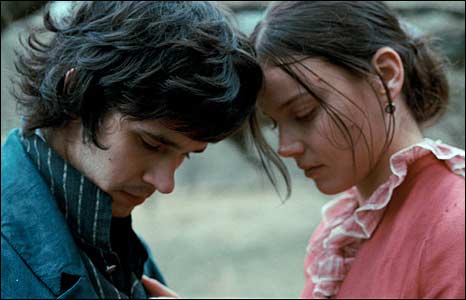The Times recently came out with their list of not the most important or highest grossing, but of the The 100 Best Films of the Decade. Quite the  daunting task, I don't envy them for having the guts to put together such an ambitious list, and so soon! (probably too soon) After studying the list and chatting about it with a couple of my friends and work-mates I came to the conclusion that not only was their list flawed but purposefully so. How else could one explain the inclusion of Team America: World Police or Casino Royale, especially so high on the list (#5 and #8, respectively)? These lists are almost always created by newspapers, magazines, and online publications in order to get readers riled up. To get internet bloggers (myself included) to write about and discuss and otherwise bash their list all the while netting them millions of visitors and thus raising their online ad revenues (I don't have any hard facts to support this claim, but it's not all that far fetched, is it?).Anywho, as I'm sure is the case with many others, I thought, "why don't I go ahead and create my own list of the best films of the decade?" And so, what I've decided to do is, in the days leading up to my this list (which is still being processed) I'll post old reviews I've written of my favorite films of this decade past. I'm sure this will all be quite anti-climatic, but here goes...
daunting task, I don't envy them for having the guts to put together such an ambitious list, and so soon! (probably too soon) After studying the list and chatting about it with a couple of my friends and work-mates I came to the conclusion that not only was their list flawed but purposefully so. How else could one explain the inclusion of Team America: World Police or Casino Royale, especially so high on the list (#5 and #8, respectively)? These lists are almost always created by newspapers, magazines, and online publications in order to get readers riled up. To get internet bloggers (myself included) to write about and discuss and otherwise bash their list all the while netting them millions of visitors and thus raising their online ad revenues (I don't have any hard facts to support this claim, but it's not all that far fetched, is it?).Anywho, as I'm sure is the case with many others, I thought, "why don't I go ahead and create my own list of the best films of the decade?" And so, what I've decided to do is, in the days leading up to my this list (which is still being processed) I'll post old reviews I've written of my favorite films of this decade past. I'm sure this will all be quite anti-climatic, but here goes...
I'll begin with one of my favorite films of 2006 and (as I say at the end of the review) the best American film of that year...
Half Nelson (2006)
(2006)
Director: Ryan Fleck
Writers: Anna Boden, Ryan Fleck
Producers: Alex Orlovsky, Jamie Patricof, Lynette Howell, Rosanne Korenberg, Anna Boden
Starring: Ryan Gosling, Shareeka Epps, Anthony Mackie, Monique Curnen, Karen Chilton, Tina Holmes, Collins Pennie
In Ryan Fleck's audacious and gritty debut film, Half Nelson, Ryan Gosling (The Notebook) plays Dan, a young and rebellious school teacher working in the inner city trying his best to influence, and at times inspire, his students as best he can. Simultaneously he’s slipping deeper and deeper into drug addiction that's only an outward reflection of his greater disillusionment and frustration with his life and the world. One evening after a school basketball game, one of his students, Drey, played by talented new-comer Shareeka Epps, catches her coach/teacher (Gosling) getting high in a stall in the women's locker room. The relationship the two of them eventually form is a powerful one, carrying the rest of the film through to its stunning conclusion.
As I mentioned previously, Half Nelson is a film about disillusionment. Gosling’s character is disillusioned with his life and where it’s headed, but even more so, he’s disillusioned with the world around him and thus feels inadequate and useless, which compels him to fall further into a major drug addiction. As Gosling’s character tells the children in his junior high history class, the culprit is the "machine" that "keeps all of us down". The problem is, we’re all part of this machine (i.e. the white man, the government, prisons, etc.); but, as the ingeniously interspersed readings of civil rights history remind us, and as he informs and reminds his kids, we all have a choice. In essence, this choice comes down to how much we allow the machine to affect us; how much of ourselves will we allow it to take, and how much will we give to help change it? Anyone whose real, who isn't lying to themselves or living in a fantasy world, can't help but appreciate this film and identify with the two lead characters, Dan and Drey. They are characters that require thought and time to fully understand. These are REAL people, real people in real situations.
From its romanticized and perfectly cast leads, to its gritty, nothing but the bare essentials cinematography, Half Nelson is a near perfect film; the kind of film for anyone who is afraid to go to the movies, deterred by the very genre this film enlivens: the inspirational drama. First time feature film director and co-writer Ryan Fleck steers way clear of the sentimentality that so easily could’ve inundated the pitch-perfect, so unpretentious it could've been a documentary screenplay.
Gosling and Epps give performances of rare and subtle brilliance which undoubtedly contribute to the film’s powerful, stirring statement and inspirational closing act. Their characters are both real and restrained. Epps is more than believable as a confused, but strong and confident girl struggling with adolescence and the depravity of the world around her. In Gosling's case, this is certainly an Oscar worthy performance. A true case of less is more... a LOT more.
Adding another layer of gravity is the film's perfectly timed and powerful soundtrack. Broken Social Scene provides several exclusive and/or extended tracks that add that extra bit of "oomf" precisely when the film needs it; especially during the film's climax, a scene without a word of dialogue which is one of the most brilliant, powerful, and telling scenes of recent memory.
If you can find Half Nelson playing near you, I highly encourage you to get out and see it soon. You won't easily find better performances, a more streamlined screenplay, or more refreshing directing. This is the best American film of 2006.
 Though not that obscure, The Brothers Bloom is a movie more people need to know about. Director and writer Rian Johnson's second film (his first being the cult film noir Brick), The Brothers Bloom is at first hilarious, then profound, then gripping, and finally tragically moving. Starring Adrien Brody, Mark Ruffalo, Rinko Kikuchi, and the stunning Rachel Weisz, it's about two con-men (the aforementioned brothers) in quite the love/hate relationship. The younger, Bloom played by Brody, has been living a lie his entire life and he's tired of it, playing the charming male lead in all of his brother's con's. He wants what he calls an "unwritten life" (don't we all?) and eventually agrees to one last con before he gives it up for good. That last con is on Weisz's character, Penelope, a rich recluse who is more than they ever could've realised.
Though not that obscure, The Brothers Bloom is a movie more people need to know about. Director and writer Rian Johnson's second film (his first being the cult film noir Brick), The Brothers Bloom is at first hilarious, then profound, then gripping, and finally tragically moving. Starring Adrien Brody, Mark Ruffalo, Rinko Kikuchi, and the stunning Rachel Weisz, it's about two con-men (the aforementioned brothers) in quite the love/hate relationship. The younger, Bloom played by Brody, has been living a lie his entire life and he's tired of it, playing the charming male lead in all of his brother's con's. He wants what he calls an "unwritten life" (don't we all?) and eventually agrees to one last con before he gives it up for good. That last con is on Weisz's character, Penelope, a rich recluse who is more than they ever could've realised.




















